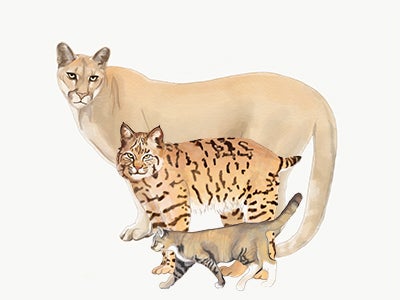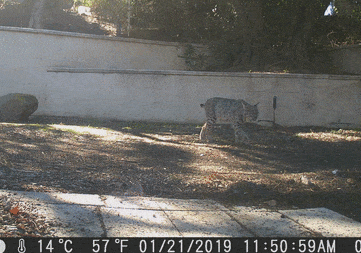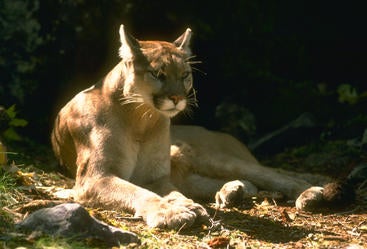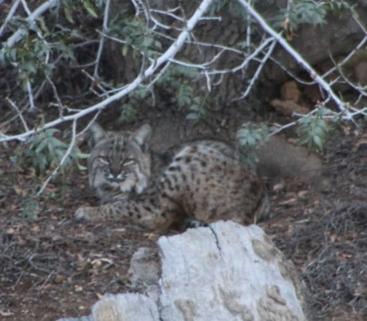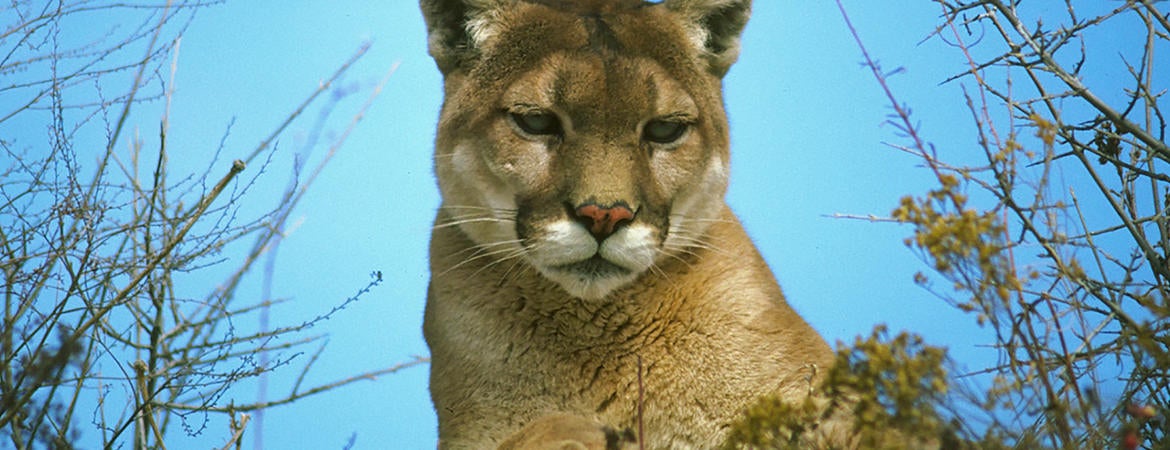
People venturing into the wild hills of the Botanic Gardens or on the south edge of campus might receive friendly warnings to watch out for mountain lions. A persistent rumor holds that the big cats roam the more rugged parts of campus and nearby mountains.
Nestled against the Box Springs Mountains, with the 40-acre Botanic Gardens forming most of its southern border, the UC Riverside campus rubs shoulders with valuable habitat for many species of birds, mammals, reptiles, and insects.
However, there is no evidence that mountain lions are regular campus visitors. Most mountain lion sightings at UC Riverside are probably really bobcats, say experts.
Janine Almanzor, curator of the Botanic Gardens, said that since at least the mid-1980s Botanic Gardens staff have never sighted a mountain lion, but there have been anecdotal reports.
“A few years ago, a visitor said he saw one jump over the west fence of the Gardens into the arroyo area between the Gardens and the campus. He said it was about 160 pounds and had a long tail. That sounds like a mountain lion, but the staff never saw it and he didn't take a picture,” she said.
“We do have resident bobcats and have had kittens in the Gardens. One bobcat that has been puzzled over is tall and lanky, which could have led to speculations about mountain lions,” said Jodie Holt, Botanic Gardens director.
Adult mountain lions, also called cougars or pumas, are about 2-3 feet high at the shoulder and weigh 64-220 pounds, depending on sex, with close-cropped, smooth, tawny coats and a long, cylindrical tail. Females and males both vaguely resemble a slender African lioness and prefer to hunt deer. Bobcats fall somewhere between a very large housecat and a medium-sized dog in size—12-24 inches tall and 9-40 lbs. They sport shaggy, tan coats with spots that might not be noticeable from a distance and a short, stubby tail about 4-6 inches long. Bobcats hunt small animals, like rabbits, and are common throughout North America.
How can something small enough to fit on a person’s lap be confused for something big enough to kill a deer?
“Bobcats get mistaken for mountain lions all the time,” said Anne Hilborn, a postdoctoral scholar in the Department of Evolution, Ecology, and Organismal Biology who studies cheetahs and other big cats. “Unless you have a fair amount of experience with both, it’s hard to assess the size difference. So if you see an unfamiliar tan cat you think cougar.”
Case in point: Early last fall the Internet went crazy over sightings of a tiger in Knoxville, Tennessee. When someone finally captured a photograph, the “tiger” was clearly a bobcat.
Bobcats have been photographed on campus numerous times. The same cannot be said for mountain lions. There has not been a single mountain lion on campus or in the Botanic Gardens known to have been documented by photographs, footprints, or feces in many years.
Dick Newell, a biologist and expert wildlife tracker who volunteers at the UCR Herbarium, recalled discovering a pile of mountain lion poop, or scat, during a lunchtime walk through the avocado orchard up the hill behind the Herbarium about 3-4 years ago.
"It was full of deer hair, like mountain lion scat always is," he said. The road had been driven over too many times to hold tracks, but there was no doubt in his mind that it came from a mountain lion. "But it wasn't steaming fresh and it was obvious the mountain lion wasn't living in the area. It was just passing through."
Other than Newell's find, Herbarium curator Andrew Sanders said, "I’d not heard of one near campus for a few decades. Plaster casts of fresh tracks in mud at the end of Big Springs Road were taken around 30 years ago. They’re scarce and elusive, but they’re around."
“I can’t say they’re not around but we haven’t gotten any calls,” said John Freese, interim chief of the UC Riverside Police Department. “The last one was maybe a year ago. Whenever they have been reported I’m pretty sure they’re bobcats. I can confirm bobcat sightings, as one of our patrol officers photographed one on campus several years ago.”
UCR Police have responded to calls about bobcats, rattlesnakes, wild burros, an injured owl, and a terrifying shriek that turned out to be two skunks mating.
“It was the strangest thing,” Freese said. “It sounded like a baby screaming.”
That doesn’t mean it’s impossible for the predators to make a guest appearance from time to time, just unlikely.
“It doesn’t make sense that mountain lions would live in or near the Botanic Gardens,” Hilborn said, pointing out that the gardens and adjacent hills are bordered on the west and south by the 60/215 Freeway, the UCR campus on the north, and a large residential neighborhood on the east. “Their habitat is so fragmented. They’d be hungry all the time.”
Winston Vickers, a veterinarian who directs the California Mountain Lion Project at UC Davis’ Karen C. Drayer Wildlife Health Center, has co-authored numerous studies of the lion population in the Santa Ana Mountains of northern San Diego and southern Riverside counties. He was a member of a team that studied and ultimately recommended a wildlife undercrossing beneath the 15 Freeway in Temecula to prevent inbreeding and help that population survive.
“It is certainly possible, even likely, that occasionally a mountain lion might show up in your vicinity, but I would imagine it would be just very occasional,” Vickers said in an email. “That is because UCR and Box Springs Mountains are at the west end of a long, narrow area that, from a mountain lion’s perspective, is less than ideal habitat stretching from the San Jacinto Mountains to your area.”
Vickers said that a typical male mountain lion territory is 125 square miles, and even more in less desirable terrain like the area surrounding campus. Habitat fragmentation, urbanization, and diminished food resources mean there is almost certainly no resident mountain lion population near UC Riverside. Therefore, any mountain lions that might appear at UCR are likely to be young males striking out on their own to find new territory.
“Mountain lions have been sighted in the Box Springs Mountains. I know of two sightings in the last 25 years that were made by very reliable people. I investigated one of these sightings and found some tracks in the mud of the stream in Two Trees Canyon,” said Ken Halama, director of the Motte Rimrock, Emerson Oaks, and Box Springs Reserves of the UC Natural Reserve System.
“Unfortunately this was before the proliferation of smartphones and I did not take any pictures. Now, whether they live in the area or are just dispersing through is an entirely different question. Since the number of sightings have been so rare, my guess is that they were just passing through.”
Dustin McLain, chief of Parks and Resources at Riverside County Regional Parks and Open-Space District, said that mountain lions have been observed on Box Springs Mountain in the past but nothing recently.
“We have had positive sightings by our caretaker employee and have collected a few paw print casts. When we do see them, we do not see them for long. It seems, geographically, this is the southwest terminus of their home range, with the majority of their home range being comprised of San Timoteo Canyon/Cherry Valley/Oak Glen and up into the San Bernardino Mountains,” he said
Alternatively, Vickers suggests a territorial male lion that showed up near UCR could be at the far west end of his territory that would likely stretch east to the lands south of Beaumont and Banning.
“A female range is smaller but your area would also be at the western end of a territory and not visited regularly, I would imagine, unless there was a good deer population,” he said.
Deer are not abundant in the Box Springs Mountains but McLain said some mountain lions might follow a seasonal deer migration into the area.
“The San Bernardino/Oak Glen herd usually migrates in late winter/early spring if conditions warrant extending their range further southwest due to limited availability of foraging habitat,” he said. “We usually see this in multiple drought years and can be considered not likely to occur, but it does happen from time to time.”
Unlike bobcats, mountain lions are shy, most active at night, and rarely seen even in their core territories.
“Bobcats are urban adapters,” Halama said. “They are comfortable living on the edge of a human area.”
Like their fellow urban adapters, coyotes, bobcats are nonchalant around humans. They also tend to be active during the day, increasing the probability of meeting people.
“I’ve been surprised by how much visibility carnivores have in Southern California,” Hilborn said, adding that in some other parts of the country carnivores like bobcats and coyotes are very timid around humans because they are hunted extensively.
“I saw a bobcat on the UCR campus and was shocked that they’re doing so well and aren’t being persecuted by people. In six years of living in rural western Virginia I never saw one, despite it being a much less urban place than Riverside. But since people don't actively persecute them in Southern California, they can be pretty blasé about humans, even in areas where there are a lot of people.”
This peaceful co-existence can happen because bobcats usually leave pets alone and pose little to no threat to humans. If mountain lions were regularly moving through the residential neighborhood between the Box Springs Mountains and campus, Halama said, “Something would happen to make people aware of their presence. Cats and other animals would start disappearing.”
All the experts agree the odds of seeing a mountain lion on the UCR campus or in the Botanic Gardens are vanishingly small but not zero.
“A young migrating male can show up virtually anywhere—even somewhere like the Macy's at the Temecula mall a couple of years ago—but would be in your area briefly and just moving through,” Vickers said.
Anyone lucky enough to catch a unique glimpse of a mountain lion near the UCR campus will probably see it running away. Mountain lions typically avoid people. The California Department of Fish and Wildlife says that a person is 1,000 times more likely to be struck by lightning than attacked by a mountain lion.
Like all wild animals, however, they can be unpredictable and dangerous if they feel threatened or are sick, injured, or starving. The California Department of Fish and Wildlife recommends the following tips to avert or manage mountain lion encounters:
- Do not hike, bike, or jog alone. Stay alert on trails.
- Avoid hiking or jogging when mountain lions are most active – dawn, dusk, and at night.
- Keep a close watch on small children.
- Off leash dogs on trails are at increased risk of becoming prey for a mountain lion.
- Never approach a mountain lion. Give them an escape route.
- DO NOT RUN. Stay calm. Running may trigger chase, catch and kill response. Do not turn your back. Face the animal, make noise and try to look bigger by waving your arms, or opening your jacket if wearing one; throw rocks or other objects. Pick up small children.
- Do not crouch down or bend over. Squatting puts you in a vulnerable position of appearing much like a 4-legged prey animal.
- Be vocal; however, speak calmly and do not use high pitched tones or high pitch screams.
- Teach others how to behave during an encounter. Anyone who runs may initiate an attack.
- If a lion attacks, fight back. Research on mountain lion attacks suggests that many potential victims have fought back successfully with rocks, sticks, garden tools, even an ink pen or bare hands. Try to stay on your feet. If knocked down, try to protect head and neck.
- If a mountain lion attacks a person, immediately call 911.
- Report unusual mountain lion behavior to your local California Department of Fish and Wildlife regional office.
Learn more about how to identify wildlife tracks and signs at OC Trackers.
Header photo: A mountain lion (California Department of Fish and Wildlife)

